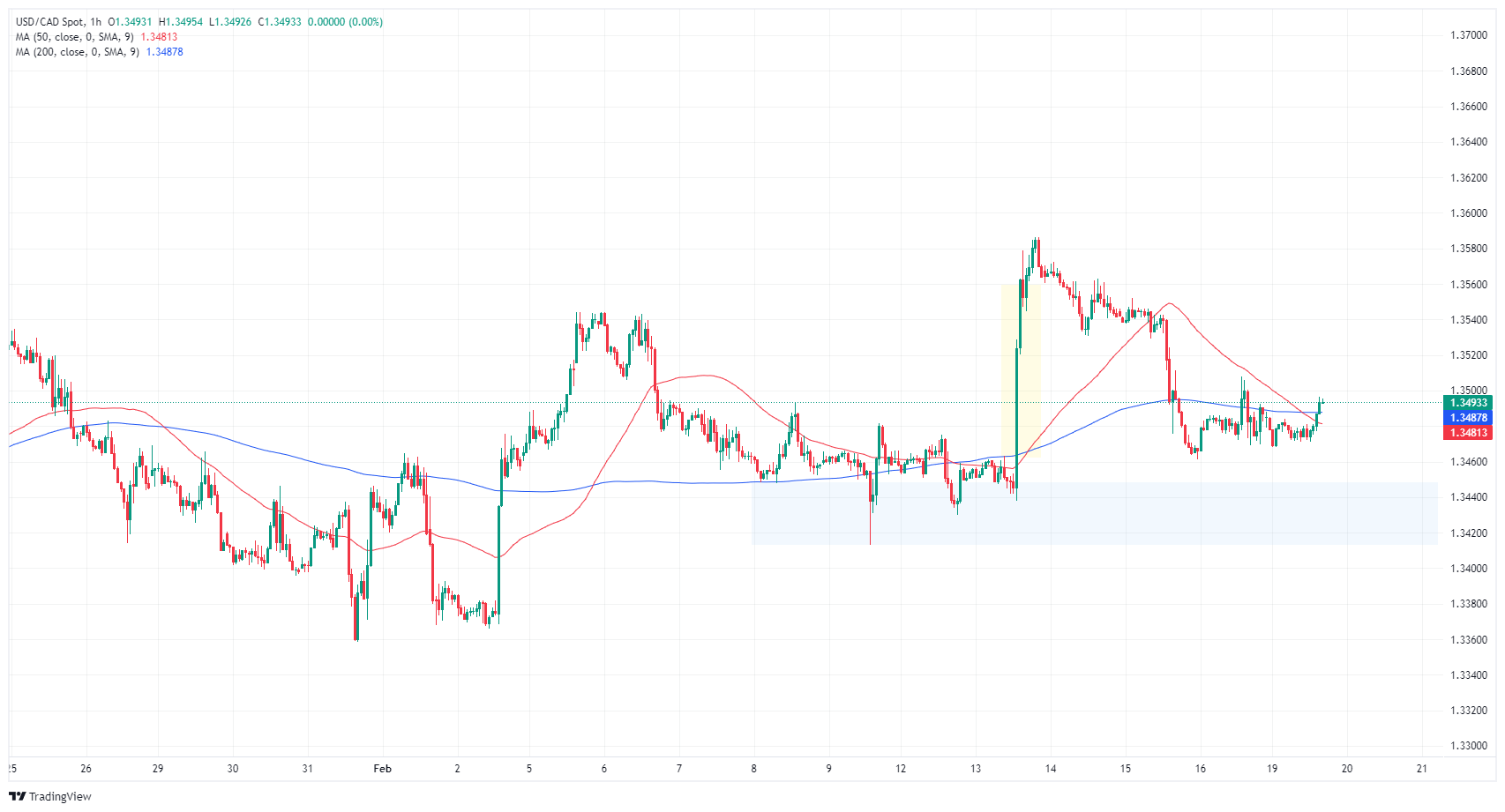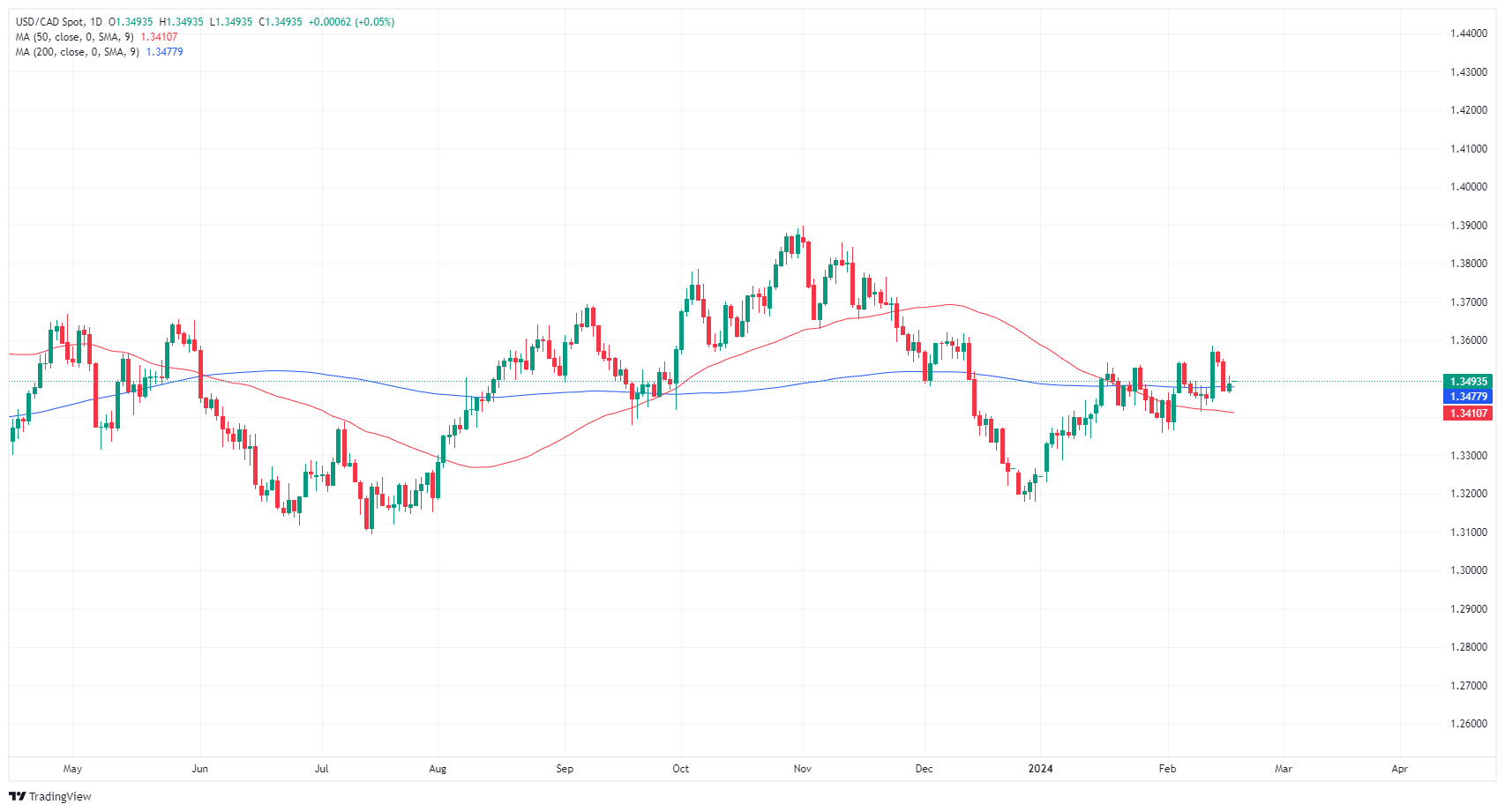Most recent article: USD/CAD knocked back on Tuesday after Canadian CPI inflation prints below expectations
- Thin Monday market churn as traders wait for big data prints this week.
- Canada, US both have bank holidays on Monday, throttling trading volumes.
- Tuesday brings Canadian CPI inflation, US FOMC Meeting Minutes on Wednesday.
The Canadian Dollar (CAD) is stuck in a near-term technical range as the new trading week kicks off with a thin market profile. Canadian and US financial institutions are dark on Monday, with two-thirds of Canadians taking the day off. Canada’s financial sector, specifically the Toronto Stock Exchange, is closed for the day. The US is also observing Presidents’ Day, and American institutions will start the new trading week on Tuesday.
Canada brings another Consumer Price Index (CPI) inflation print on Tuesday, and broader markets will be keeping a close eye on Wednesday’s Federal Open Market Committee (FOMC) Meeting Minutes as investors look out for how close the US Federal Reserve (Fed) is to cutting interest rates.
Daily digest market movers: Canadian Dollar churns in flat-sided markets
- The Canadian Raw Material Price Index rose 1.2% in January versus December’s -4.9%.
- Canadian MoM Industrial Product Prices shrank a scant -0.1% in January compared to December’s -1.6% (revised slightly from -1.5%).
- Both metrics are decidedly low-impact, barely moved the needle despite Raw Materials posting a fourth straight month in contraction territory.
- Tuesday’s YoY Canadian CPI inflation is expected to tick down slightly to 3.3% from the previous period’s 3.4%.
- MoM Canadian CPI inflation is expected to rebound to 0.4% in January from December’s -0.3%.
- Canada CPI Preview: Inflation likely eased in January.
- Canadian Retail Sales slated for Thursday are expected to show a MoM rebound to 0.8% in December compared to November’s -0.2%.
- Wednesday’s FOMC Meeting Minutes will pull the veil back on the Fed’s internal discussions about the US central bank’s interest rate stance.
- According to the CME’s FedWatch Tool, money markets are expecting a first rate trim from the Fed in June, with over 90% odds of another rate cut in July.
Canadian Dollar price today
The table below shows the percentage change of Canadian Dollar (CAD) against listed major currencies today. Canadian Dollar was the strongest against the Swiss Franc.
| USD | EUR | GBP | CAD | AUD | JPY | NZD | CHF | |
| USD | 0.04% | 0.10% | 0.10% | -0.04% | 0.03% | -0.24% | 0.19% | |
| EUR | -0.05% | 0.05% | 0.05% | -0.08% | -0.01% | -0.29% | 0.14% | |
| GBP | -0.10% | -0.06% | 0.00% | -0.13% | -0.06% | -0.34% | 0.10% | |
| CAD | -0.08% | -0.03% | 0.01% | -0.13% | -0.05% | -0.33% | 0.11% | |
| AUD | 0.04% | 0.10% | 0.14% | 0.12% | 0.08% | -0.21% | 0.23% | |
| JPY | -0.03% | 0.00% | 0.08% | 0.06% | -0.08% | -0.28% | 0.15% | |
| NZD | 0.25% | 0.27% | 0.34% | 0.33% | 0.20% | 0.26% | 0.43% | |
| CHF | -0.19% | -0.14% | -0.09% | -0.11% | -0.23% | -0.16% | -0.44% |
The heat map shows percentage changes of major currencies against each other. The base currency is picked from the left column, while the quote currency is picked from the top row. For example, if you pick the Euro from the left column and move along the horizontal line to the Japanese Yen, the percentage change displayed in the box will represent EUR (base)/JPY (quote).
Technical analysis: Canadian Dollar mixed on quiet Monday
The Canadian Dollar (CAD) spreads on Monday, mixed against the major currency basket at the start of the new trading week. The CAD is flat against the Pound Sterling (GBP), up a scant tenth of a percent against the Swiss Franc (CHF), and down a third of a percent against the broadly-recovering New Zealand Dollar (NZD) on Monday.
The USD/CAD is cycling within near-term technical boundaries near 1.3500, and the pair remains just north of a supply zone between 1.3440 and 1.3420. The pair spent most of the last week closing last Tuesday’s Fair Value Gap (FVG), and traders will be looking for a break of structure to bring the USD/CAD back into buying territory below 1.3460.
USD/CAD remains hampered by the 200-day Simple Moving Average (SMA) at 1.3478, and near-term price action is finding thin but steady technical support from the 50-day SMA near 1.3410.
USD/CAD hourly chart
USD/CAD daily chart
Canadian Dollar FAQs
What key factors drive the Canadian Dollar?
The key factors driving the Canadian Dollar (CAD) are the level of interest rates set by the Bank of Canada (BoC), the price of Oil, Canada’s largest export, the health of its economy, inflation and the Trade Balance, which is the difference between the value of Canada’s exports versus its imports. Other factors include market sentiment – whether investors are taking on more risky assets (risk-on) or seeking safe-havens (risk-off) – with risk-on being CAD-positive. As its largest trading partner, the health of the US economy is also a key factor influencing the Canadian Dollar.
How do the decisions of the Bank of Canada impact the Canadian Dollar?
The Bank of Canada (BoC) has a significant influence on the Canadian Dollar by setting the level of interest rates that banks can lend to one another. This influences the level of interest rates for everyone. The main goal of the BoC is to maintain inflation at 1-3% by adjusting interest rates up or down. Relatively higher interest rates tend to be positive for the CAD. The Bank of Canada can also use quantitative easing and tightening to influence credit conditions, with the former CAD-negative and the latter CAD-positive.
How does the price of Oil impact the Canadian Dollar?
The price of Oil is a key factor impacting the value of the Canadian Dollar. Petroleum is Canada’s biggest export, so Oil price tends to have an immediate impact on the CAD value. Generally, if Oil price rises CAD also goes up, as aggregate demand for the currency increases. The opposite is the case if the price of Oil falls. Higher Oil prices also tend to result in a greater likelihood of a positive Trade Balance, which is also supportive of the CAD.
How does inflation data impact the value of the Canadian Dollar?
While inflation had always traditionally been thought of as a negative factor for a currency since it lowers the value of money, the opposite has actually been the case in modern times with the relaxation of cross-border capital controls. Higher inflation tends to lead central banks to put up interest rates which attracts more capital inflows from global investors seeking a lucrative place to keep their money. This increases demand for the local currency, which in Canada’s case is the Canadian Dollar.
How does economic data influence the value of the Canadian Dollar?
Macroeconomic data releases gauge the health of the economy and can have an impact on the Canadian Dollar. Indicators such as GDP, Manufacturing and Services PMIs, employment, and consumer sentiment surveys can all influence the direction of the CAD. A strong economy is good for the Canadian Dollar. Not only does it attract more foreign investment but it may encourage the Bank of Canada to put up interest rates, leading to a stronger currency. If economic data is weak, however, the CAD is likely to fall.
Information on these pages contains forward-looking statements that involve risks and uncertainties. Markets and instruments profiled on this page are for informational purposes only and should not in any way come across as a recommendation to buy or sell in these assets. You should do your own thorough research before making any investment decisions. FXStreet does not in any way guarantee that this information is free from mistakes, errors, or material misstatements. It also does not guarantee that this information is of a timely nature. Investing in Open Markets involves a great deal of risk, including the loss of all or a portion of your investment, as well as emotional distress. All risks, losses and costs associated with investing, including total loss of principal, are your responsibility. The views and opinions expressed in this article are those of the authors and do not necessarily reflect the official policy or position of FXStreet nor its advertisers. The author will not be held responsible for information that is found at the end of links posted on this page.
If not otherwise explicitly mentioned in the body of the article, at the time of writing, the author has no position in any stock mentioned in this article and no business relationship with any company mentioned. The author has not received compensation for writing this article, other than from FXStreet.
FXStreet and the author do not provide personalized recommendations. The author makes no representations as to the accuracy, completeness, or suitability of this information. FXStreet and the author will not be liable for any errors, omissions or any losses, injuries or damages arising from this information and its display or use. Errors and omissions excepted.
The author and FXStreet are not registered investment advisors and nothing in this article is intended to be investment advice.
Recommended content
Editors’ Picks

Gold sits at record highs above $3,000 on escalating geopolitical tensions
Gold price is sitting at record highs beyond $3,000 early Tuesday on intensifying geopolitical Middle East tensions. Israel resumes military operations against Hamas in Gaza after the group rejected US proposals for extending ceasefire. Further US-Iran tensions add to the latest leg up in the safe-haven Gold.

EUR/USD defends 1.0900 ahead of German vote on spending plans
EUR/USD bounces off 1.0900 in the European session on Tuesday. Optimism around the German vote on the spending plan and Trump-Putin talks offsets escalating Middle East and trade tensions, fuelling fresh US Dollar weakness while lifting the pair.

GBP/USD rebounds toward 1.3000 on renewed US Dollar selling
GBP/USD bounces back toward 1.3000 in the European trading hours on Tuesday. The pair finds fresh support from a renewed US Dollar selling as investors look past the Middle East tensions, anticipating the US-Russia takls on Ukraine peace deal.

Ethereum consolidates below $2,000 as Standard Chartered alters its prediction for 2025
Ethereum remained just below $2,000 in the Asian session on Tuesday as Standard Chartered's Global Head of Digital Assets Research, Geoffrey Kendrick, updated the bank's 2025 price forecast for ETH.

Five Fundamentals for the week: Fed leads central bank parade as uncertainty remains extreme Premium
Central bank bonanza – perhaps its is not as exciting as comments from the White House, but central banks still have sway. They have a chance to share insights about the impact of tariffs, especially when they come from the world's most powerful central bank, the Fed.

The Best brokers to trade EUR/USD
SPONSORED Discover the top brokers for trading EUR/USD in 2025. Our list features brokers with competitive spreads, fast execution, and powerful platforms. Whether you're a beginner or an expert, find the right partner to navigate the dynamic Forex market.